Mastering the Formal Table Setting: A Complete Guide
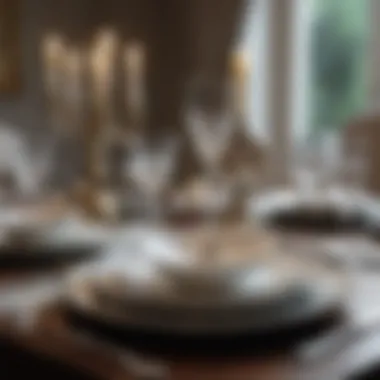
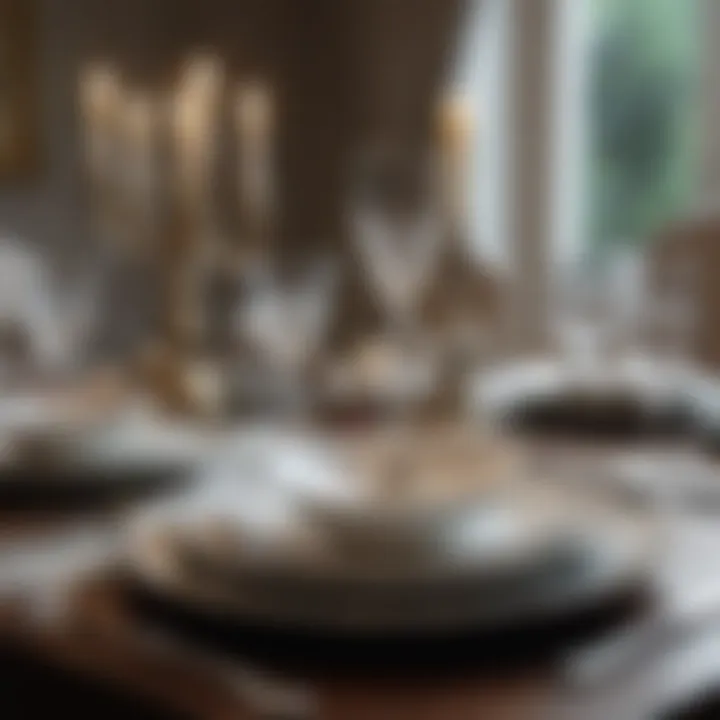
Intro
Setting a formal table is more than just a practical task; it is an artful expression of hospitality and attention to detail. The process involves understanding not only the physical arrangement of items but also the etiquette that guides the dining experience. A well-set table can elevate any occasion, creating an ambiance that encourages engagement and enjoyment among guests.
This guide delves deep into the components of a formal table setting, detailing the arrangements, utensils, and manners that constitute an elegant dining experience. Each element, from the choice of tablecloth to the specific placement of silverware, holds significance. Understanding these aspects equips hosts with the knowledge to impress and elevate their hosting skills.
While many may approach table setting as a mere formality, it is worth exploring the deeper implications behind each choice. Whether it’s a dinner party, a holiday gathering, or a business meal, a formal table not only complements the meal but also reflects the host’s personality and style.
The following sections will breakdown the necessary components and techniques for setting a formal table, ensuring that readers are well-prepared for any event.
Understanding the Formal Table Setting
The formal table setting is much more than just an arrangement of dishes and utensils. It represents a blend of tradition, etiquette, and aesthetics. Understanding this concept is crucial for anyone looking to master the art of hosting sophisticated gatherings. A well-set table elevates the overall dining experience, making guests feel valued and respected.
A formal setting often adheres to specific guidelines and conventions that have evolved over time. These conventions are important as they convey respect for the occasion and the individuals present. Knowledge of the formal table setting is necessary for various events ranging from weddings to important business dinners, allowing hosts to create an atmosphere of elegance.
Moreover, mastering this skill reflects attention to detail. It ensures that every guest knows how to use the silverware effectively, leading to a smooth dining experience. Properly setting the table also conveys a sense of organization and preparedness. When all elements are coordinated, it creates a visually appealing environment, enhancing the overall experience without any complications.
Definition of a Formal Table Setting
A formal table setting refers to a specific arrangement of utensils, dishes, and glassware designed to facilitate a traditional dining experience. It typically includes a minimum of one set of forks, knives, and spoons per course, as well as corresponding glassware for beverages. Each element in the arrangement serves a defined purpose, guiding the guest through the meal in an orderly fashion.
In essence, the formal table setting is about both aesthetics and functionality. While it demonstrates a level of decorum, it also aids in the practical execution of each course in the meal. Topics such as silverware placement, glassware positioning, and linen selection are all integral to this concept. Having a clear understanding of these components ensures that a host can create an authentic formal dining environment.
Historical Context
The roots of the formal table setting can be traced back to various cultures and eras. Originating in Europe, particularly during the Renaissance, the formal dining customs were initially reserved for aristocrats. As time progressed, these customs were adopted by the middle class, particularly in the 19th century.
During this time, the industrial revolution led to the mass production of tableware, making formal dining more accessible. This period also established many of the etiquette rules that are still adhered to today, such as the arrangement of utensils according to their order of use. The Victorian era introduced intricate table settings, where elaborate floral arrangements and fine china were commonplace.
In contemporary society, formal dining continues to hold significance as a means of celebrating important occasions. Understanding the historical context enriches the appreciation for current practices, offering insight into how traditions shape modern etiquette and dining standards.
Essential Components of Silverware
In every formal dining experience, the essential components of silverware play a pivotal role. They not only enhance the aesthetic of the table but also contribute significantly to the overall dining functionality. Properly selected and arranged silverware ensures that guests have the right tools for each course, thereby delivering an elegant and smooth dining experience.
Silverware is more than just cutlery; it includes forks, knives, spoons, and specialized utensils. Each type of silverware serves a distinct purpose and is crafted to facilitate specific dining tasks. Understanding these components is crucial for anyone looking to master the art of table setting. This section will explore the various types of silverware, their materials, and the importance of each in a formal setting.
Types of Silverware
Forks
Forks are a fundamental part of any table setting. They serve as the primary tool for consuming food, making their correct arrangement essential. A major characteristic of forks is their tines. Most commonly, a standard dinner fork has four tines, allowing for efficient food spearing and picking.
The versatility of forks makes them a popular choice. Standard forks are suitable for most meals, while dessert forks are usually smaller and often have a more delicate design. A unique feature of forks is their varied shapes tailored for specific dishes, such as salad forks or fish forks. Understanding which fork to use for each course is part of refined dining etiquette.
Knives
Knives are critical in a formal place setting, primarily designed for cutting food. Their sleek designs and sharp blades allow diners to enjoy various meats and vegetables effortlessly. The most prominent type, the table knife, is often characterized by a rounded tip and a wide blade, making it effective for most dining tasks.
Knives are popular for their functional aspects. Their orientation, facing the plate, signifies readiness for use. There are specialized knives like butter knives, which are smaller with a blunt edge to spread butter comfortably without tearing the bread. This distinction in functionality makes knives an indispensable component in any formal dining arrangement.
Spoons
Spoons hold a distinct place in the silverware hierarchy. They are primarily used for consuming liquids and softer food items. The common soup spoon, with its round bowl, excels at delivering broth or soup in an elegant manner. This is important in a formal setting where presentation matters.
The broad characteristic of spoons is their versatility. Besides soup spoons, there are dessert spoons, which are slightly smaller and suited for sweet dishes. A unique aspect of spoons is their varying sizes and shapes, tailored to specific purposes such as tea spoons or serving spoons. Proper placement enhances the dining experience, allowing easy access to the required spoon for each course.
Specialized Utensils
Specialized utensils are additional tools that can elevate a formal dining experience. These include serving spoons, ladles, and even pairings for specific dishes like seafood forks or chocolate fondue forks. Their presence signifies attention to detail and an understanding of culinary variety.
The key characteristic of specialized utensils lies in their design tailored for distinct functions. For example, a fish fork has a wider, flattened shape perfect for delicate fish fillets. These utensils can enhance the efficiency of serving and eating, while their inclusion reflects a high standard of dining etiquette.
Material Considerations
The choice of material for silverware significantly impacts the dining experience and complements the overall table decor. Each material carries unique properties that affect durability, maintenance, and appearance.
Stainless Steel
Stainless steel is a practical choice for many households due to its strength and corrosion resistance. This type of silverware is durable and can withstand daily use without losing its shine. An essential aspect of stainless steel is its affordability compared to other materials, making it favorable for casual and formal settings alike.
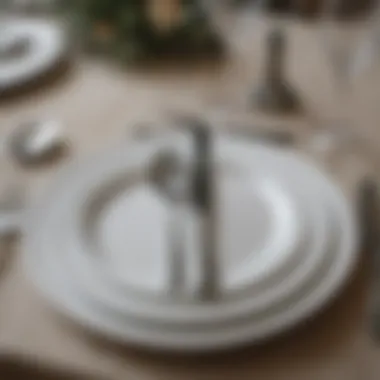
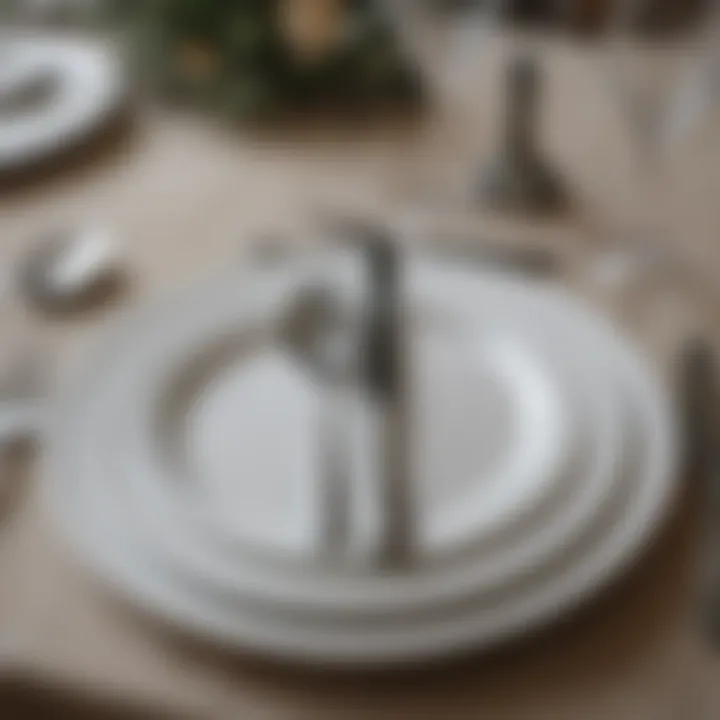
One unique feature is that stainless steel can mimic the appearance of traditional silverware while being easier to maintain. However, it may lack the classic elegance associated with higher-end options.
Silver Plated
Silver plated utensils offer a more cost-effective yet elegant alternative to solid silver. The outer layer of silver gives these utensils a gleaming finish, adding to the aesthetic appeal of a formal table setting. They are often lightweight and can be crafted in intricate designs.
One disadvantage is their susceptibility to tarnishing, requiring regular polishing to maintain their luster. Still, they remain a popular choice for those who wish to achieve a classic look without the expense of solid silver.
Sterling Silver
Sterling silver is often considered the gold standard in silverware. Made from 92.5% silver, it is revered for its beauty and timeless quality. The classic shine of sterling silver elevates any dining occasion, making it a preferred choice for formal gatherings.
The unique feature of sterling silver is its intrinsic value. It does require care to prevent tarnishing and scratching, which may deter some potential users. Nonetheless, its unparalleled elegance and richness justify its place at the table for special events.
The Arrangement of Silverware
The arrangement of silverware plays a pivotal role in the overall presentation of a formal table setting. This aspect is not just about aesthetics; it serves functional purposes that enhance the dining experience. Properly arranged silverware ensures that diners can easily access the utensils they need, contributing to a smooth flow during the meal. Moreover, it reflects attention to detail, which is crucial in formal occasions. When guests arrive and see a thoughtfully arranged table, it sets a tone of elegance and care, signaling that the host values their presence.
Standard Arrangement Guidelines
Standard arrangement guidelines provide a foundational framework for setting silverware. Here are the basic principles:
- Placement: The utensils should be placed in the order of use from outside to inside. This means that diners will use forks, knives, and spoons from the outermost pieces first.
- Forks on the Left: All forks should be positioned to the left of the plate. The salad fork, if used, should be placed closest to the plate, followed by the dinner fork.
- Knives on the Right: Knives are positioned to the right of the plate, with the cutting edge facing inward. This placement facilitates easy access and ensures safety.
- Spoons: Soup spoons or other specialized spoons should be to the right of the knives. Things like dessert spoons can be placed above the plate or brought out with the dessert.
- Utensils for Shared Dishes: If there are communal dishes, appropriate serving utensils should be placed on or near them to enhance accessibility.
These guidelines, though simple, create a structured environment that promotes formality and order.
Order of Use
Understanding the order of use is essential for both hosts and guests. The sequence in which utensils are utilized follows a systematic approach:
- Appetizers: Begin with the outermost fork for the appetizer courses. This might include a small fork for salads if presented before the main dish.
- Main Course: For the main course, the inner fork and knife are used. This is typically the dinner fork and knife, positioned closest to the plate.
- Side Dishes: If side dishes are served, use the additional utensils positioned for these, like a specific fork or spoon if needed.
- Dessert: Dessert utensils can either be placed on the table at the start or presented with the dessert. If placed on the table from the beginning, it usually goes above the main plate.
Guests should adhere to these stages for an optimal dining experience, while hosts should guide diners smoothly through the courses.
Placing the Utensils: A Step-by-Step Approach
In formal dining, the placement of utensils plays a crucial role in both aesthetics and functionality. Understanding how to position each piece correctly can elevate the dining experience significantly. This section explains the systematic approach to placing utensils, highlighting essential aspects, benefits, and considerations.
Setting the Forks
Placement to the Left
The placement of forks to the left of the plate is fundamental in formal table settings. This arrangement is traditional and reflects etiquette standards observed globally. Forks are positioned with the tines facing up, which aligns with the natural grip of the diner’s hand when reaching for them. This setup aids in intuitive use, allowing guests to easily access their utensils from left to right.
The key characteristic of this placement is its simplicity. It not only maintains order but also ensures that diners feel comfortable. Because forks are often used first, having them readily accessible contributes positively to the overall dining flow. One unique feature of placing forks to the left is that it signifies readiness. An orderly arrangement contributes to a calm dining atmosphere, enhancing the overall experience, which many hosts strive to achieve.
Fork Types
Understanding the types of forks is equally important in setting a formal table. Different forks have specific uses; for instance, the dinner fork is broader, while the salad fork is smaller. This variety allows for a range of courses during a formal meal. Each type of fork serves its distinct purpose, ensuring that guests have the appropriate tool for each dish.
The key characteristic here is functional diversity. Having various forks provides versatility and maintains the sophistication of the table setting. A unique feature lies in the fact that the arrangement of forks can also indicate the meal’s formality. For example, the inclusion of a fish fork can signal a more elaborate dining experience. However, confusion can arise if guests are unfamiliar with which fork to use, making clear guidance essential.
Setting the Knives
Placement to the Right
Knives are traditionally placed to the right of the plate, with blades facing inwards. This arrangement not only prevents accidental cuts but also reflects a sense of orderliness. Positioning knives in such a manner allows for efficient access, as most right-handed individuals find it comfortable to reach for them from that side.
The key characteristic of this general placement is safety. By orienting the blades inward, the risk of injury is minimized, presenting a thoughtful approach to guest comfort. The unique feature of this arrangement also emphasizes the etiquette of the meal. Having knives at the ready, yet safely positioned, aligns well with the decorum expected at formal events. While this position is beneficial, it can sometimes cause confusion for left-handed diners, making it important to consider all guests’ needs.
Knife Orientation
The orientation of knives also holds significance. As mentioned, the blade’s inward position is common, and it not only enhances safety but also promotes the smooth flow of dining. This approach helps guests to focus on their meals rather than adjusting utensils awkwardly.
The key characteristic of knife orientation is a deliberate effort towards ease of dining. An effective arrangement fosters an atmosphere where guests can enjoy their meals without distraction. A unique feature here is the ability to place specialized knives for specific courses, such as butter knives alongside bread plates. However, introducing too many types of knives can lead to confusion, making simplicity often the best choice.
Setting the Spoons
Placement for Soup Spoons
When setting spoons, the placement for soup spoons is on the outer right, next to the knife. This position allows for easy access when the soup course is served. Having soup spoons at hand facilitates a seamless transition from one course to another.

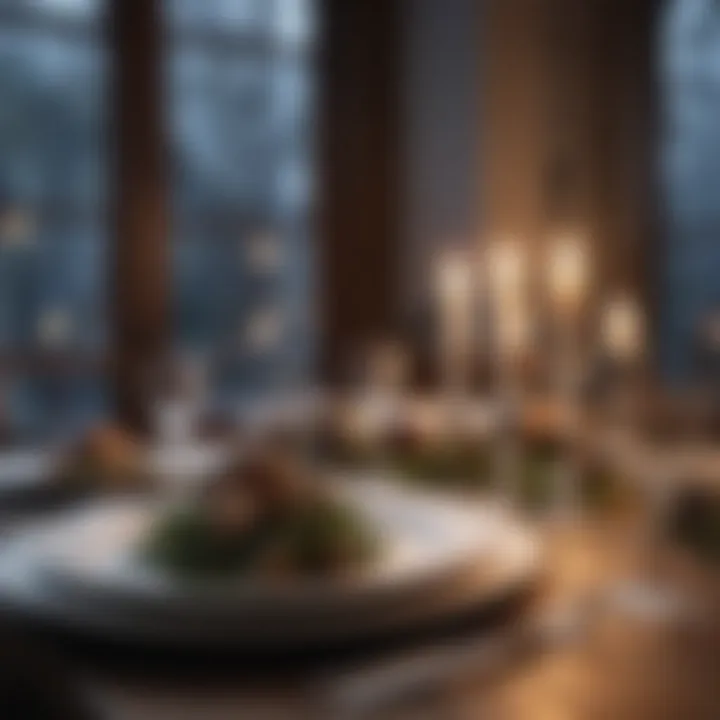
The key characteristic of this placement is convenience. Guests can enjoy the soup without hesitation, improving their dining experience. One unique advantage of this arrangement is that it indicates the expected order of courses. However, as with other utensils, guests who may not know which spoon to use could benefit from clear instructions.
Other Spoons
When considering other spoons, such as dessert and tea spoons, their placement should follow the same logic of accessibility. Dessert spoons often rest above the plate, while tea spoons can be placed on the side of or alongside tea cups. This arrangement keeps the utensils contextually relevant to their intended use, enhancing the overall dining flow.
The key characteristic of other spoons is versatility. Each type has specific usage, and their thoughtful placement helps in developing a structured meal. One unique feature is that some settings also incorporate specialty spoons for dishes like aspics or sorbets. While this achieves a sophisticated appearance, introducing too many utensils may overwhelm guests, especially if they are unfamiliar with formal dining standards.
In summary, understanding the art of placing utensils is fundamental for creating an elegant and functional formal table setting. From forks to knives and spoons, each piece contributes to the overall dining experience while adhering to established etiquette. By following these guidelines, hosts can ensure that their dinner parties are both beautiful and enjoyable.
Incorporating Glassware and Table Linens
In the context of formal dining, the choice of glassware and table linens plays a crucial role. Both elements not only enhance the aesthetic appeal but also contribute to the overall dining experience. Proper glassware and linens can elevate a simple meal into an elegant occasion. Understanding their significance helps hosts create a cohesive atmosphere that reflects attention to detail.
Choosing the Right Glassware
Water Glasses
Water glasses are essential in any formal table setting. They serve a fundamental purpose; to keep guests hydrated throughout the meal. The typical characteristic of these glasses is their size, larger than wine or champagne glasses, making them suitable for water and other non-alcoholic beverages. A key benefit of using dedicated water glasses is simplicity. They can be made from various materials such as glass or crystal. The clarity of these materials helps create an impression of freshness, aligning perfectly with the theme of a refined dining experience. However, guests often overlook them amidst more ornate options, which can diminish their presence in overall table aesthetics.
Wine Glasses
Wine glasses are vital when serving wine with meals. Their design enhances the wine's aroma and flavor. A distinct characteristic of wine glasses is their varying shapes, designed specifically for red, white, or sparkling wines. This specialization is a crucial advantage, as it allows the host to offer the optimal experience for each type of wine served. Choosing glassware that compliments the meal can enhance flavor perception. Nevertheless, the diversity in wine glass shapes can be confusing for some hosts, which leads to common mistakes in selection and placement.
Champagne Flutes
Champagne flutes are synonymous with celebrations and special occasions. Their tall, narrow design encourages the signature bubbling effervescence that champagne is known for. A defining feature of flutes is their ability to preserve carbonation for a longer period, enhancing the drinking experience. Champagne flutes signal a festive atmosphere, making them popular for toasting and celebrating. However, they can be less versatile compared to other types of glassware. If the setting is more casual, their formal appearance may seem out of place, challenging hosts to balance tradition and ambiance in their presentation.
Selecting Table Linens
Tablecloths
Tablecloths serve both a decorative and protective role in formal dining. They are essential for setting the tone of the event. The material and color can influence the entire ambiance of the table setting. Popular choices include cotton, linen, and polyester, each contributing its unique texture and quality. A significant characteristic is their ability to create uniformity across the setting, tying together the various elements such as glassware and silverware. However, tablecloths can require more maintenance than other options, making them less appealing for less formal gatherings where cleanup is a priority.
Napkins
Napkins are an often-overlooked component but crucial for functionality and decor. Beyond their practical use, they offer an opportunity for creative presentation. The key characteristic of napkins is their versatility; they can be folded in various ways to create visual interest. Choosing high-quality napkins can add an elevated touch to the setting, complementing other linens and glassware. However, the wrong choice in color or style can clash with the overall table theme, distracting from the carefully orchestrated design.
"The power of first impressions often lies in the details of the setting. A well-selected glassware and table linen contribute significantly."
Incorporating the right glassware and table linens is a meticulous task that deserves attention. Their selection should resonate with the theme and purpose of the occasion, enhancing both aesthetic appeal and the dining experience.
Etiquette for Formal Dining
Understanding etiquette for formal dining is essential. It represents not just the rules of behavior, but also conveys respect for the dining experience, hosts, and guests. Incorporating proper dining etiquette enhances the atmosphere, making meals more enjoyable and memorable. This section covers specific elements and benefits of etiquette that can elevate any dining occasion.
Rules of Engagement
Proper rules of engagement play a fundamental role in formal dining. These rules dictate how guests should interact with each other and the host. A few of the key rules include:
- Wait for the Host: Do not begin eating until the host has started. This shows respect.
- Use Utensils Properly: Familiarize yourself with the correct use of each piece of silverware. Start from the outside and work your way in.
- Engage in Conversation: Maintain light and pleasant conversation. Avoid controversial topics that may make guests uncomfortable.
Additionally, posture matters. Sit up straight and keep elbows off the table while dining. This not only looks polite but also presents a composed image to your fellow diners.
Common Mistakes to Avoid
Mistakes in formal dining can be distracting and may cause discomfort. Here are common missteps to steer clear of:
- Talking with Food in Your Mouth: This is considered impolite. Always chew and swallow before speaking.
- Ignoring Table Manners: For instance, using a mobile device during the meal can be seen as disrespectful to the host and guests.
- Improper Napkin Use: Place the napkin on your lap when sitting down, and don’t leave it on the table after the meal.
You can avoid these mistakes by practicing beforehand. Rehearsing dining etiquette can improve poise, allowing for a more enjoyable experience.
"Etiquette is simply the mechanics of social interaction, which can significantly shape our perception and experience of formal dining."
Variations for Different Occasions
When planning a formal table setting, it is crucial to consider the context of the gathering. Each occasion necessitates a different approach, which can reflect the tone of the event and enhance the overall dining experience. Variations for different occasions also offer opportunities to express creativity while adhering to the foundational principles of formal dining. Adjusting elements like silverware arrangement, glassware selection, and centerpieces can transform a standard dining setup into something exquisite and relevant to the event.
Consider the elements involved:
- Event Theme: The theme plays a significant role in determining the style and layout of the table.
- Guest Preferences: Understanding the guests' backgrounds and preferences can help tailor the table to suit their tastes.
- Meal Type: The food being served can affect the utensil placement as certain meals may require specific types of cutlery or glassware.
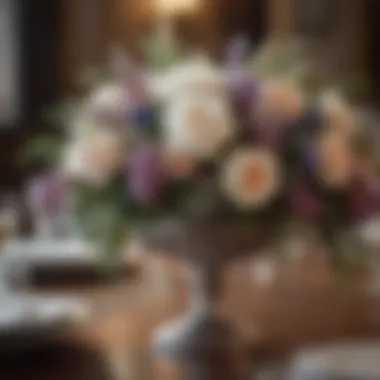
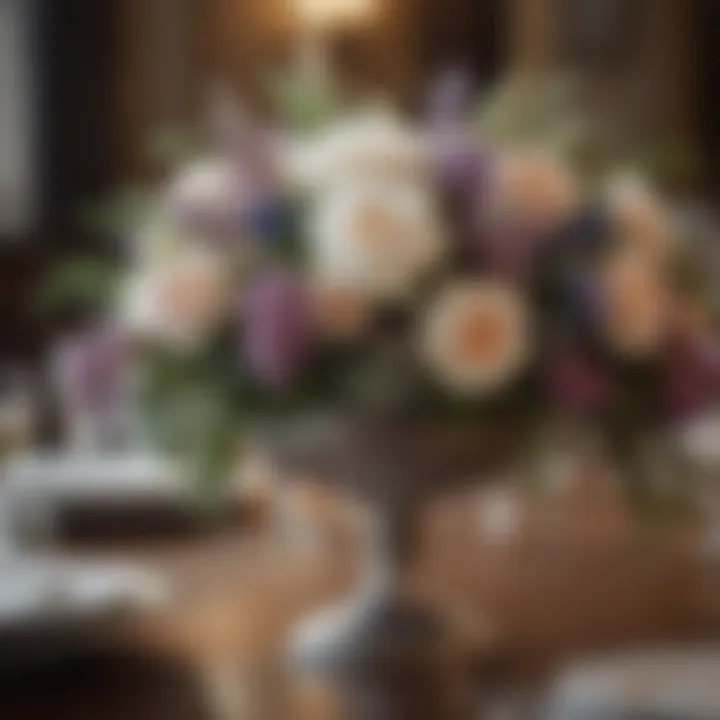
In summary, matching the table setting to the occasion enriches the dining experience and creates an atmosphere conducive to the type of event.
Celebratory Dinners
Celebratory dinners often exude joy and festivity, whether it is for a birthday, anniversary, or holiday gathering. The table setting for these occasions typically embodies a more vibrant and appealing design.
Key considerations include:
- Mood and Colors: Incorporating cheerful colors through linens and decorations. It aids in creating a lively atmosphere.
- Centrepiece Choices: Using floral arrangements or thematic decor that resonate with the celebration. These elements not just serve as decorations, but they also initiate conversations.
- Service Style: Depending on the formality, one may choose plated service or buffet style. This decision impacts the spatial arrangement of the table settings.
Each detail adds to the celebratory nature, allowing guests to enjoy their meal and enhance their experience together.
Business Meetings
Business meetings call for a more professional ambiance, and table settings should reflect that. The arrangement often communicates respect and sets the tone for the meeting.
Considerations for this scenario include:
- Simplicity and Clean Lines: Opt for minimalistic decoration to avoid distractions, ensuring that the focus remains on discussions and presentations.
- Functional Layout: Arranging silverware and glassware in a manner conducive to easy service can enhance the flow of the meeting. Each utensil should be easily accessible to avoid awkward moments.
- Time Management: A well-planned table can lead to more efficient dining experiences, allowing time for meeting discussions.
The presence of an organized, professional table setting can significantly impact the overall effectiveness of business meetings, making careful planning essential.
The Importance of Presentation
The significance of presentation in setting a formal table cannot be overstated. A well-presented table communicates respect for your guests and enhances the overall dining experience. It sets the tone for the meal and prepares diners for the culinary journey ahead. The appearance of the table reflects the host's thoughtfulness and attention to detail, which is often appreciated by guests.
Visual Appeal
Visual appeal in table setting involves the arrangement, color, and style of the components on the table. The first impression of a dining experience comes from how the table looks. A beautiful table can make an ordinary meal feel exceptional. For example, using a color scheme that complements the meal enhances the visual dynamics. Matching tablecloths with glassware or silverware creates an inviting atmosphere.
Additionally, varied heights in glassware and centerpieces can add interest. Tall vases with flowers can create a focal point, while lower arrangements allow for easy conversation.
Some key elements to consider for visual appeal include:
- Color Coordination: Choose a palette that reflects the occasion and season.
- Symmetry vs. Asymmetry: Both styles can be effective, depending on the overall look desired.
- Lighting: Proper lighting can enhance the colors and textures, making the table more inviting.
"Visual appeal is not only about aesthetics; it also contributes to the mood and comfort of the dining experience."
Creating a Cohesive Look
Creating a cohesive look requires attention to detail throughout the entire table setup. Cohesion can be achieved through consistent color schemes, material choices, and overall themes. Each element should complement the others, leading to a unified dining atmosphere.
For instance, if one chooses porcelain dinnerware, it is best to stick with matching glassware and napkins. If a rustic theme is desired, wooden utensils or earthy colors can enhance the overall look.
To achieve a cohesive design, consider these aspects:
- Theme Consistency: Whether formal, casual, or thematic, every piece should align with the chosen theme.
- Material Harmony: Avoid mixing too many materials. Consistency in metal finishes, such as using all stainless steel or all silver, creates a refined look.
- Layering: Use table runners, chargers, or placemats for additional depth without overwhelming the setup.
In summary, presentation plays a critical role in formal dining setups. It touches on visual appeal and the importance of a cohesive look. With a thoughtful arrangement and keen attention to detail, hosts can elevate their dining experiences, making them memorable for their guests.
Final Considerations
When it comes to the art of setting a formal table, the final considerations are just as crucial as the initial setup. These finishing touches can greatly influence the overall dining experience and reinforce the themes of elegance or formality that one wishes to convey. A carefully reviewed table layout ensures that all elements work harmoniously, providing comfort and convenience for guests.
Reviewing Your Set-Up
Once you have arranged the silverware, glassware, and linens, it is imperative to conduct a thorough review of the entire set-up. This will involve checking the alignment of the utensils, ensuring that they are placed appropriately according to usage. The distance between plates and utensils should be comfortable for the guests, allowing enough space without looking sparse.
Additionally, double-check the placement of the centerpiece. It should not obstruct anyone's view or conversation. A well-set table reflects thoughtfulness and care from the host. Here are some specific points to consider:
- Symmetry: Ensure that each side of the table mirrors the other for aesthetic appeal.
- Accessibility: Make sure that all dining items are easily reachable from each place setting.
- Cleanliness: Inspect all items for cleanliness. Accumulation of dust or smudges can detract from the visual effect you aim to achieve.
- Lighting: Consider the lighting around the table. Proper illumination enhances the ambiance significantly.
Frequently Asked Questions
In this section, readers will find responses to some prevalent inquiries regarding formal table settings. These FAQs address common topics and help clarify other aspects of formal dining.
What is the proper way to serve courses?
Typically, courses are served from the left of the guest, while clearing dishes is done from the right to maintain fluidity during the meal.
Can I mix different styles of silverware?
While it is possible to mix styles, it is advisable to keep a consistent theme. This guarantees that the table does not appear chaotic or mismatched.
Why choose cloth napkins over paper ones?
Cloth napkins elevate the dining experience significantly. They add a tactile richness, making the meal feel more formal, and they can also be folded into elegant designs.
Is it necessary to use a tablecloth?
While not required, using a tablecloth adds an additional layer of sophistication and protection for the surface beneath.
Remember, a well-executed table setting reflects a host's etiquette and respect for their guests.
By understanding these final considerations, the art of setting a formal table can exceed mere functionality. The ultimate goal is to cultivate an environment that is both inviting and reflective of the host's elegance and style.







